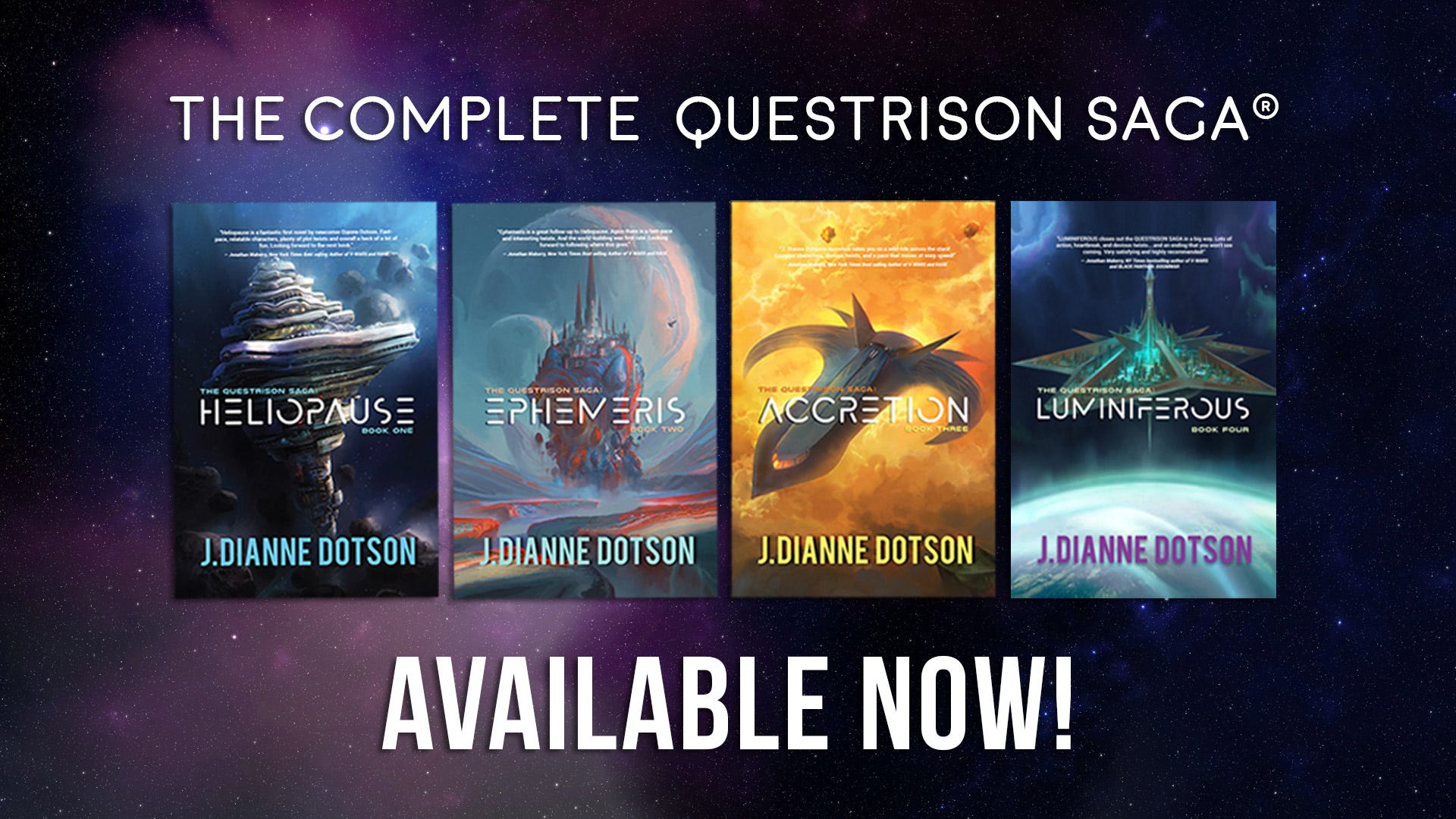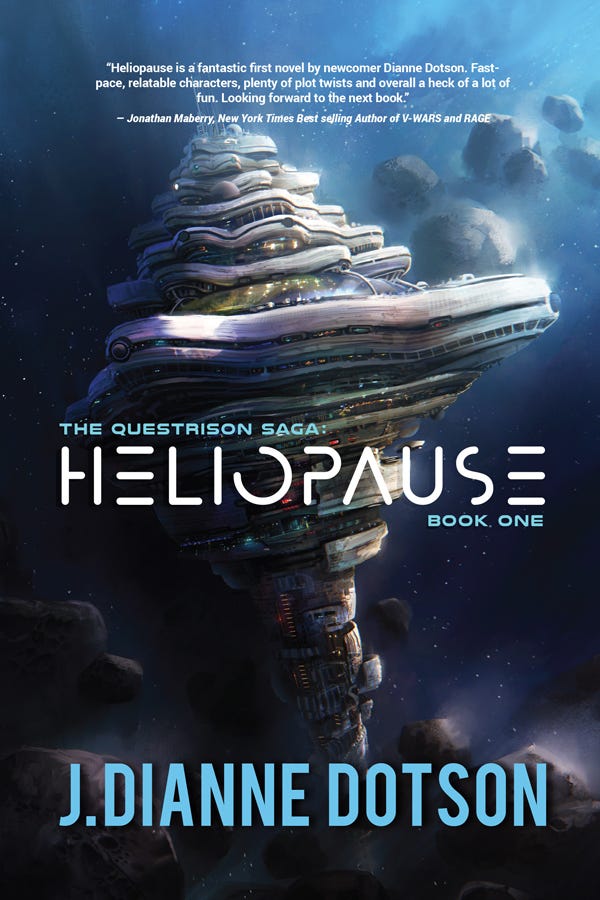Making The Questrison Saga®️- Vol. 1
My book-writing history began when I was still a child in the 1980s. Learn how I built this epic saga over time.
What Is The Questrison Saga®️?

The Questrison Saga®️ is my four-book space opera series, comprised of Heliopause, Ephemeris, Accretion, and Luminiferous. Written by me under my alt pen name J. Dianne Dotson.
How Did the Series Begin?
When I was a child in the 1970s and 1980s, I cut my teeth on Star Wars, Star Trek, Lost in Space reruns, The Wizard of Oz, Clash of the Titans, the original Battlestar Galactica, Wonder Woman, and then The Empire Strike Back, Return of the Jedi, Back to the Future, Starman, Blade Runner, Transformers, He-Man, She-Ra, Jem and the Holograms, The Mighty Orbots, and many more iconic shows and movies of the time. I also watched at probably too young an age John Carpenter’s The Thing, and several horror movies. I then watched Aliens first, and went back to watch Alien. (Later influences, in the 1990s, included Dark City and Macross Plus.) It was during this formative era that I decided I wanted more strong women characters, who had their own space adventures, and so the idea of the character Galla-Deia was born.
She was ageless, born of a powerful substance called diamethyst, and she lived with her surrogate robot father, Oni-Odi, on the immense, traveling star-city Demetraan. Galla looks human but is not; she’s part of a set of beings who take on the appearance of the species they’re set to protect, called the Representatives. Galla does stand out in one regard, however, from the first glance. Her hair behaves of its own volition, and often betrays her inner feelings. Galla began as a quite innocent being, fully formed, but with a childlike temperament as she slowly learned what it meant to fit in with humans. One of those humans, in fact the first she ever met, would train her to become a Representative.
But before I wrote about that human, I had already written out the endgame of The Questrison Saga: starting with my first novel in 1987, and finishing in 1988 with its sequel. In these books, Galla was already fighting in the battle against the monstrous entity Paosh Tohon, hellbent on overtaking the galaxy. She needed the right team to help her, and then once gaining that, she underwent a great trauma that prevented her from doing the very thing she wanted to do: save the galaxy. It was a tumultuous duology of books, but ambitious for my age, and full of worlds that I came to think of as almost real, for I put so much effort into making them feel lived-in. I event made travel guides for them, particularly the planet Quopeia.
These books underwent rewrites as I matured and my writing improved. I realized there needed to be layers to these characters. And then life happened: I was overworked in school all the way through the end of college, and living in times of great personal stress. I set the saga aside. In 2005, however, I returned to it, and that time I wrote the bulk of what is now Ephemeris, the second book in the series. Originally meant to be the first book, Ephemeris introduces Galla-Deia and some of the most important characters to her. However, when she meets the human trainer, I realized I didn’t like his appearing whole-cloth. He intrigued me. I wanted to tell his story too, especially that of his family. Just how did the humans get out into deep space? So I wrote Heliopause.

I dreamed up the character Forster, in one of those fitful, between waking/sleeping kind of dreams. A man in his forties, he was walking down this hallway, feeling disgusted, not liking the soft floors of the space station he worked on. He had blown it with his girlfriend again. Forster was miserable and bored, but getting by. And he never once thought of himself as particularly remarkable. But then all hell breaks loose, and he discovers he has a latent ability, just as something breaches the research station Mandira, at the edge of the solar system: the heliopause. His enigmatic coworker Efron seems to know more about what’s going on than makes sense. His friend Meredith, missing a daughter for twenty years, seeks answers. An attack on the station hints that her daughter may somehow be involved. It’s up to Forster to figure out the multiple mysteries and try to prevent the menace from taking over Mandira Research Station…before moving into the rest of the Solar System.
I published Heliopause in 2018, and so far, it is still my biggest seller (including my traditionally published books so far). I sometimes wonder if I should have published Ephemeris first after all, since it serves as both prequel and sequel to Heliopause, and its probably the more crucial of the two for the rest of the series, given it introduces Galla-Deia. But as it stands, I liked Heliopause’s aspects of mystery and cosmic horror framing for humans what might happen to us, if we don’t start paying attention. And when you read them in order, (bracing yourself for the third book, Accretion), the payoff is massive in the fourth and final book, Luminiferous.
Because I had written this saga over the span of decades, I knew exactly where it was going, and I dropped a number of hints in Heliopause that are not apparent unless you reread it. Many readers stop with this book, but I urge you to continue with the remaining three. I put my heart, soul, and decades of care and thought into them all.
And buckle up. Something sinister is growing out in the deep between the stars…
You can order the saga in paperback or ebook from most reputable booksellers.
My next post will be an in-depth description of some of the world-building in Heliopause as well as its major players. I’ll do this for each book.
I hope you enjoyed this post!
Write on!
Jendia




